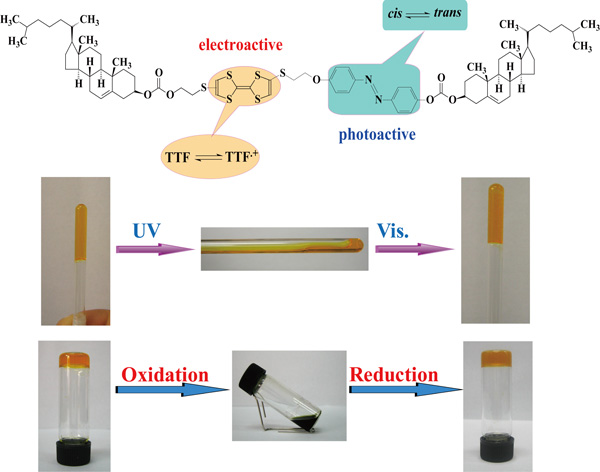Low molecular weight gelators can self-assemble into the organogels with 3D networks through nonconvalent forces,such as hydrogen bonding, metal coordination, van der Waals interaction, and p–pstacking. Low-molecular weigh organogelators have attracted substantial attentions in supramolecular chemistry and materials science due to their unique characteristics and wide range of potential applications.Of particular interest for organogel material science are ‘‘smart gels’’, i.e. gels whose Sol-gel transitions can be controlled in response to external stimuli. Control of these organization processes by chemical or physical stimuli represents a prime scientific challenge and opens up a new way to develop smart materials.
Under the support of National Natural Science Foundation of China, the Ministry of Science and Technology of China, and the Chinese Academy of Sciences, the researchers in CAS Key Laboratory of Organic Solids made new significant progresses in the stimuli responsive gels based on low-molecular weight gelators. Recently, they report a multistimuli responsive organogelators, featuring electroactive TTF and photoresponsive azobenzene groups. By manipulating the redox state of the TTF group in this gelator, the gel-sol transition can be reversibly tuned by either chemical or electrochemical oxidation/reduction reactions. Alternatively, the photoisomerization of the azobenzene group in this organogelatorcan also trigger the gel-sol transition. Therefore, organogels with this organogelatorrespond not only to thermal stimuli but also to redox reactions and light irradiation(J. Am. Chem. Soc., 2010, 132, 3092).
Additionally, they reported gels responding to chemical reaction and organogels exhibiting interesting spectral properties. These results have been published on Adv. Funct. Mater. 2010, 20, 3244;Adv. Funct. Mater., 2010, 20, 36; Langmuir, 2010, 26, 3165;Langmuir, 2010, 26, 11720; Langmuir, 2009, 25, 11436;Langmuir, 2007, 23, 1478; Langmuir, 2007, 23, 9195;Chem. Phys. Lett., 2009, 475, 64; Chem. Phys. Lett. 2006, 428, 130; Chin. J. Chem., 2010, 28, 622.

Reversible Multistimuli Responsive Organogels
